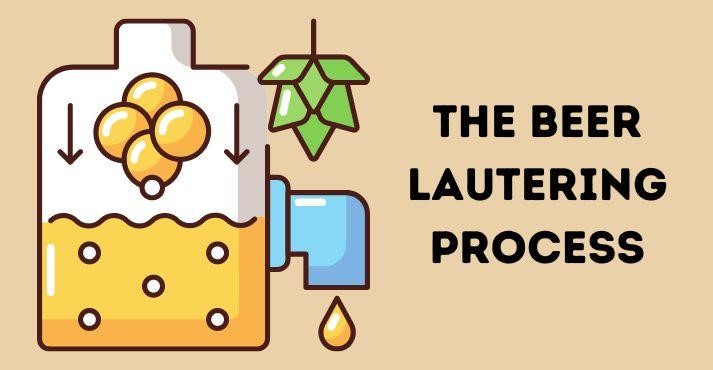Have you ever wondered what happens after mashing in the beer brewing process? How does the sweet liquid known as wort separate from the grainy mash to create the delicious beers we enjoy?
This important step is called beer lautering, which is essential in shaping the flavor and clarity of the final product.
Lautering plays a crucial role in brewing by efficiently separating the wort, the liquid containing all those precious sugars, from the spent grains.
This separation ensures the wort is clean and clear, setting the stage for fermentation. The clarity and quality of this liquid directly affect the taste and appearance of the beer you pour into your glass.
In this article, we’ll look into the details of beer lautering, exploring what it is, why it’s essential, and how it contributes to the brewing process.
What is Beer Lautering?
Lautering is a vital step in the beer industry, particularly in the brewing process. But what exactly is it? After mashing, beer lautering separates the liquid wort from the solid grain husks.
During mashing, the grains are mixed with hot water to extract sugars, but after this step, the liquid (wort) needs to be separated from the grain husks to move forward in brewing.
This is where lautering comes into play. It efficiently filters out the spent grains, ensuring that only the clear wort, rich in fermentable sugars, is collected.
This step is vital because the quality of this separation directly impacts the final beer’s clarity and flavor. If the process is not done correctly, unwanted particles from the grains can end up in the wort, affecting the beer’s taste and appearance.
The Lautering Process Explained

It’s essential to walk through the process step by step to understand the importance of lautering in brewing.
Each stage plays a significant role in ensuring that the final beer, whether craft beer or gluten-free beer, is flavorful and clear.
1. Mashing: The Precursor to Lautering
Before lautering in brewing can begin, the mashing process must be completed. Mashing involves mixing crushed grains, typically malted barley, with hot water to convert the starches in the grains into fermentable sugars.
The result of this process is a thick, porridge-like mixture called mash. The temperature during mashing is carefully controlled to optimize enzyme activity, ensuring the maximum conversion of starches into sugars.
This step is critical because it creates the wort, the sweet liquid that will later be fermented into beer.
2. Transferring to the Lauter Tun
Once mashing is complete, the next step is transferring the mash to a specialized vessel called the lauter tun.
The lauter tun is a large, perforated vessel designed to facilitate the separation of the wort from the solid grain husks. The term lauter comes from the German word meaning “to filter” or “to clarify,” which perfectly describes the purpose of this equipment.
As the mash is transferred, it settles on the perforated bottom, with the liquid wort ready to be drawn off. At the same time, the solid husks form a natural filter bed.
3. Sparging: Extracting Remaining Sugars
After the initial wort is collected, the grains in the lauter tun still contain a significant amount of sugars. A technique called sparging is used to ensure these sugars are not wasted.
Sparging involves spraying hot water over the grains to rinse the remaining sugars. This hot water helps dissolve leftover sugars in the grain bed, maximizing sugar extraction efficiency.
The water used in sparging is often called the mash-out temperature, typically around 170 degrees Fahrenheit (77 degrees Celsius). This temperature is crucial because it stops the enzymatic activity in the mash and makes the wort more fluid, facilitating easier extraction.
4. Wort Collection
As the wort is separated from the grains, it is collected in a kettle or boiling pot for the next brewing phase. The wort collected during beer lautering should be clear and free of solid particles.
If the wort is cloudy or contains too many grain husks, it can affect the taste and appearance of the final beer. This is why lautering is so important in the overall beer production process.
The clarity and purity of the wort are directly linked to the quality of the final product. In this stage, brewers carefully monitor the flow of work to ensure that it remains clear and that the filtration process works correctly.
5. Spent Grain Disposal
Once the lautering process is complete, all that remains in the lauter tun are the spent grains. These grains have served their purpose in providing sugars for fermentation and are no longer needed in the brewing process.
However, spent grains are well-spent. Many breweries find sustainable ways to use them. For instance, spent grains can be given to farmers as animal feed, used in baking bread, or even as compost. This practice helps reduce waste and supports local agriculture and sustainability efforts.
Equipment Used in Lautering

The lautering process relies on several critical pieces of equipment to ensure that the wort is efficiently separated from the grain husks.
Each component plays a specific role in achieving a clear and high-quality wort, essential for producing excellent beer. Let’s explore the essential equipment used in beer lautering.
1. Lauter Tun
The lauter tun is the primary vessel used in the lautering process. It is typically a large, cylindrical container with a perforated bottom. The lauter tun design is crucial for its function, as it allows the liquid wort to drain through while holding back the solid grain husks.
The perforations or slots at the bottom are fine enough to prevent grains from passing through, ensuring that only the clear wort is collected. The lauter tun also often has rakes or agitators that gently stir the mash to prevent channeling, which can lead to uneven wort extraction.
2. Sparge Arm or Spray Ball
The sparge arm or spray ball is an essential tool used during the sparging phase of lautering in brewing. Its primary function is evenly distributing hot water over the grain bed in the lauter tun. This even distribution is critical to rinse the grains and extract the remaining sugars thoroughly.
The sparge arm typically rotates, spraying water consistently, while the spray ball is a fixed device that uniformly disperses water. This step ensures that the wort collected is rich in fermentable sugars, maximizing the efficiency of the brewing process.
3. False Bottom
The false bottom is an integral part of the lauter tun’s design. It acts as a sieve, allowing the liquid wort to pass through while keeping the grain husks above.
The false bottom is usually made of metal and has numerous small holes or slits that are just large enough to let the liquid through but small enough to retain the grains.
This separation is vital to ensure that the wort is free of solid particles. The false bottom also helps create a natural filter bed as the grains settle, further improving the clarity of the wort.
Impact of Lautering on Beer Quality

The lautering of the beer process is more than just a step in brewing; it plays a significant role in determining the quality of the final beer. By effectively separating the wort from the grain husks, lautering influences several key aspects of beer, including clarity, efficiency, and flavor.
1. Wort Clarity
One of the most critical impacts of proper lautering is the production of clear wort. Clear wort is essential for preventing haze in the finished beer, which can affect both its appearance and taste.
During the lautering process, the grain bed acts as a natural filter, trapping solid particles and allowing only the liquid to pass through.
If this step is not done correctly, particles from the grains can end up in the wort, leading to a cloudy beer. Clear wort ensures that the final beer has a bright, appealing appearance and a clean taste.
2. Efficiency
Lautering in brewing is also crucial for maximizing the extraction of sugars from the grain bed. Efficient lautering ensures that the maximum amount of fermentable sugars is collected, which is essential for brewing.
This improves the yield of the wort and reduces waste by ensuring that as much of the grain’s potential is used as possible. When the process is performed efficiently, brewers can extract more sugars, producing a more consistent and higher-quality beer.
3. Flavor
The flavor profile of beer is directly influenced by the composition of the wort, which is shaped during lautering. If the beer lautering process is done correctly, the wort is free of unwanted grain husks and other particles that could impart off-flavors.
Also, proper lautering helps maintain the balance of sugars and other compounds in the wort, contributing to the final beer’s desired flavor characteristics. Whether aiming for a sweet, malty brew or a crisp, clean ale, beer lautering is essential in achieving the intended flavor.
Best Practices for Successful Lautering
For brewers, following best practices during the lautering process is essential to achieve the highest quality beer. Attention to detail in these key areas can make all the difference in the final product.
1. Grain Crush Consistency
One of the most critical factors in successful lautering is ensuring a consistent grain crush. If the grains are crushed too finely, they can create a dense grain bed that impedes wort flow, leading to stuck sparges.
On the other hand, grains that are too coarse may not release enough fermentable sugars. The right balance ensures the wort can flow smoothly while maximizing sugar extraction.
2. Temperature Control
Maintaining the proper temperature during beer lautering is vital. The mash-out temp should be around 170 degrees Fahrenheit (77 degrees Celsius) to stop enzymatic activity and make the wort more fluid.
This helps prevent the extraction of unwanted tannins from the grain husks, which can lead to astringent flavors in the beer. Consistent temperature control ensures that the lautering process is efficient and the wort is high quality.
3. Patience and Timing
Timing is everything in lautering. Rushing the process can lead to cloudy wort or incomplete sugar extraction, and being too slow can reduce brewing efficiency. Patience is key; allowing the wort to drain steadily ensures a clear and clean wort, setting the foundation for great beer.
Lautering vs. Sparging: What’s the Difference?
While lautering and sparging are closely related in brewing, they serve distinct purposes. Lautering refers to the overall process of separating the wort from the grain husks, including collecting the initial wort. It involves draining the liquid from the grain bed through a filter system.
Sparging, on the other hand, is a specific step within the beer lautering process. It involves rinsing the grain bed with hot water to extract the remaining sugars.
While lautering ensures the initial separation, sparging maximizes sugar extraction, ensuring no valuable sugars are left behind. Both steps are necessary, but they each play a unique role in producing clear and high-quality wort.
Conclusion
In the brewing world, beer lautering is a critical step that ensures the quality of the final product. By carefully separating the wort from the grain husks, brewers achieve a clear, flavorful liquid ready for fermentation.
Understanding the equipment involved, such as the lauter tun and false bottom, along with best practices like maintaining consistent grain crush and proper temperature control, is essential for successful lautering.
Additionally, knowing the difference between lautering and sparging helps clarify the process’s importance. Ultimately, beer lautering is key to producing a beer that is visually appealing and rich in taste.





























